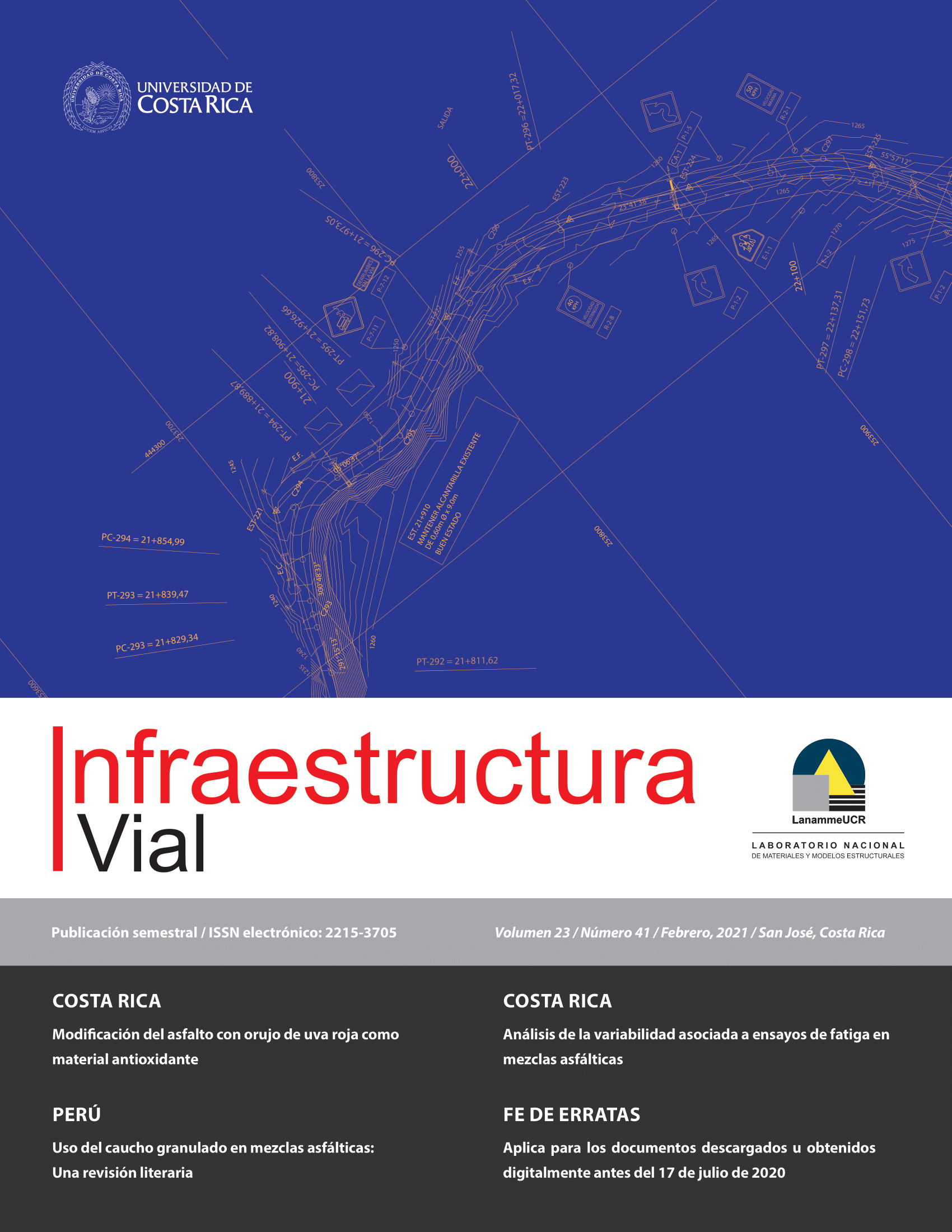Abstract
This study evaluated the antioxidant properties of red grape pomace and its benefits as an additive for asphalt binder. The samples were modified using red grape pomace as an antioxidant agent in concentrations of 1%, 2% and 3%. These samples were left outdoors to undergo natural oxidation for 12 weeks. Another set of samples were aged in an ultraviolet radiation (UV) chamber to compare the results between both oxidation methods. Three functional groups were taken in consideration to measure the degree of oxidation: the carbonyl, the carbon-carbon double bond and the sulfoxide indexes. The asphalt modified with 3% red grape pomace had the lowest increase in carbonyl index, showing that the additive works as an agent to delay the oxidation process in asphalt. The indexes obtained for the field aged samples were significantly larger than the ones associated to the UV chamber, consequently aging in a UV chamber did not properly emulate environmental conditions. Further research analyzing higher percentages of red grape pomace (greater than 3%) to understand the effect of larger contents of additive is recommended.
References
Agustin, S., Medina, L. A., Soto, H., Manzanares, F., y Gámez, N. (2014). Influence of the solvent system on the composition of phenolic substances and antioxidant capacity of extracts of grape (Vitis vinifera L.) marc. Australian Journal of Grape and Wine Research, 20(2), 208-213. DOI: 10.1111/ajgw.12063
Apeagyei, A. (2011). Laboratory evaluation of antioxidants for asphalt binders. Construction and Building Materials, 25(1), 47-53. DOI: 10.1016/j.conbuildmat.2010.06.058
Calabi Floody, A. T. (2012). Control del envejecimiento del asfalto a través de la adición de polvo deshidratado de orujo, bioproducto de la industria enológica [Tesis doctoral, Universidad Católica de Chile]. Recuperado de: https://repositorio.uc.cl/handle/11534/2925
Cheng, X., Han, S., Liu, Y., y Xu, O. (2019). Laboratory investigation on low-temperature performance of asphalt at different aging stages. Construction and Building Materials, 229, 1-8. DOI: 10.1016/j.conbuildmat.2019.116850
Faisal, H., Ahmad, M., y Tarefder, R. (2018). Effects of Pores and Oxidative Aging on the Nanomechanical Behavior of Asphalt Concrete. En International Conference on Transportation and Development 2018. Pittsburgh, Pennsylvania.
Haxo, H. E., y White, R. M. (1979). Reducing the Hardening of Paving Asphalts Through the Use of Lead Antioxidants. Association of Asphalt Paving Technologist Proceedings, 48, 611–645.
Martínez, G., y Caicedo, B. (2005). Efecto de la radiación ultravioleta en el envejecimiento de ligantes y mezclas asfálticas. [Tesis de Maestría, Universidad de Los Andes].
Parada, M. L., Lepesqueur, A. J., y Caicedo, B. (2005). Estudio del envejecimiento de mezclas asfálticas por oxidación. [Tesis, Universidad de Los Andes].
Petersen, J. (2009). A Review of the Fundamentals of Asphalt Oxidation. Transportation Research Circular, E-C140.
Petersen, C., y Glaser, R. (2011). Asphalt Oxidation Mechanisms and the role of Oxidation Products on Age Hardening Revisited. Road Materials and Pavement Design, 12(4), 795-819. DOI: 10.1080/14680629.2011.9713895
Qin, Q., Schabron, J., Boysen, R., y Farrar, M. (2013). Field aging effect on chemistry and rheology of asphalt binders and rheological predictions for field aging. Fuel, 121, 86-94. DOI: 10.1016/j.fuel.2013.12.040
Rojas, G. (2020). Implementación de protocolo de análisis en laboratorio de materiales antioxidantes para el asfalto. [Tesis de grado, Universidad de Costa Rica].
Rojas, J., Amado, H., Fernández, W., y Reyes, F. (2012). Efectos de la radiación ultravioleta en asfaltos colombianos. Ciencia e Ingeniería, 15(1), 96-104. DOI: 10.14483/23448350.3947
Sánchez, M. (2017). Implementación de Metodología de Envejecimiento de Asfaltos Mediante Radiación UV. [Tesis de grado, Universidad de Costa Rica]. Recuperado de: http://repositorio.sibdi.ucr.ac.cr:8080/jspui/handle/123456789/10368
Santucci, L. E., Goodrich, J. E., y Sundberg, J. E. (1981). The Effect of Crude Source and Additives on the Long-Term Oven Aging of Paving Asphalts. Association of Asphalt Paving Technologists Proceedings, 50, 560-571.
Tang, N., y Dong, R. (2020). Anti-Aging potential of sulphur in terminal blend rubberized asphalt binder. Construction and Building Materials, 250, 1-10. DOI: 10.1016/j.conbuildmat.2020.118858
Thermo Scientific (2012). OMNIC 9 [Software]. Recuperado de: https://www.thermofisher.com
Vargas, X., y Reyes, F. (2010). El fenómeno de envejecimiento de los asfaltos. Ingeniería e Investigación, 30(3), 27-44.
Villegas-Villegas, R. E., Baldi-Sevilla, A., Aguiar-Moya, J. P., y Loria-Salazar, L. (2018). Analysis of asphalt oxidation by means of accelerated testing and environmental conditions. Transportation Research Record, 2672(28), 244-255. DOI: 10.1177/0361198118777630
Zeng, W., Wu, S., Pang, L., Chen, H., Hu, J., Sun, Y., y Chen, Z. (2018). Research on Ultraviolet (UV) aging depth of asphalts. Construction and Building Materials, 160, 620-627. DOI: 10.1016/j.conbuildmat.2017.11.047
Zúñiga, M. (2005). Caracterización de fibra dietarían en orujo y capacidad antioxidante en vino, hollejo y semilla de uva. [Tesis de pregrado, Universidad de Chile]. Recuperado de: http://repositorio.uchile.cl/handle/2250/101763


